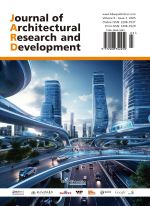Innovative Approaches to Revitalizing Urban Riversides for Enhanced Leisure and Well-being
Abstract
As societal priorities shift towards spatial quality and leisure pursuits, riverside sites offer significant potential for enhancing living environments and promoting leisure activities. This study delves into the relationship between the spatial qualities of riverside areas in old industrial cities and their capacity to foster leisure and human well-being, aiming to formulate design guidelines that preserve the unique characteristics of these sites. Noting the dearth of academic discourse on spatial qualities and design in this context, this research emphasizes the identification of key spatial features that can revitalize urban rivers as leisure destinations, which derives a set of design principles. These principles underscore the importance of diverse and distinctive spatial qualities in successful riverside regeneration, and highlight the role of high-quality spaces in promoting leisure and well-being. Finally, the research concludes with recommendations for creating impactful spatial qualities for future riverside regeneration projects.
References
Pattacini L, 2021, Urban Design and Rivers: A Critical Review of Theories Devising Planning and Design Concepts to Define Riverside Urbanity. Sustainability, 13(13): 7039. https://doi.org/10.3390/su13137039
Volker S, Kistemann T, 2013, “I’m Always Entirely Happy When I’m Here!” Urban Blue Enhancing Human Health and Well-Being in Cologne and Düsseldorf, Germany. Social Science and Medicine, 78: 113–124.
Feng P, Zhu L, Wang Y, Li J, 2019, A Brief Discussion on Urban Waterfront Landscape Design under the Healthy Landscape Perspective. Landscape Architecture, 1(3): 71–82. https://doi.org/10.31058/j.la.2019.23002
Berg SK, Stenbro R, 2015, Densification or Dilution? On Cultural and Economic Value Creation along the Aker River in Oslo, Norway. The Historic Environment: Policy and Practice, 6(3): 197–213.
Stevens Q, 2006, The Design of Urban Waterfronts: A Critique of Two Australian ‘Southbanks’. Town Planning Review, 77(2): 173–203.
Kondolf GM, Pinto PJ, 2017, The Social Connectivity of Urban Rivers. Geomorphology, 277: 182–196.
Sahin S, Sonmezer S, Kolay I, 2015, Open Space Use in Ottoman Daily Life: Landscape of Historical Dams in Istanbul. Studies in the History of Gardens and Designed Landscapes, 35(4): 279–289.
Silva-Sanchez S, Jacobi PR, 2016, Implementation of Riverside Parks in the City of Sao Paulo – Progress and Constraints. Local Environment, 21: 1–20. https://doi.org/10.1080/13549839.2014.922060
McNeill D, 2011, Fine Grain, Global City: Jan Gehl, Public Space and Commercial Culture in Central Sydney. Journal of Urban Design, 16(2): 161–178.
Jones A, 2013, A Tripartite Conceptualisation of Urban Public Space as a Site for Play: Evidence from 1South Bank, London. Urban Geography, 34(8): 1144–1170.
Prominski M, Stokman A, Stimberg D, et al., 2012, River. Space. Design: Planning Strategies, Methods and Projects for Urban Rivers. Birkhause, Berlin, Boston.

